Examination of Lower Extremity Muscle Strength
– Neurologic Examination > Motor Examination > Chapter 26 –
Examination of Lower Extremity Muscle Strength
strength is to localize neurologic pathology by looking for
characteristic distributions of muscle weakness.
Performing a Complete Neurologic Examination) should be performed on
all patients as part of the routine neurologic examination. If weakness
is suspected or found, a more detailed evaluation of lower (and upper)
extremity muscles is indicated to try to localize the patient’s
pathology.
of the lower extremities end primarily within the lumbar spinal cord,
proceeding no further caudally than the first sacral level. The lower
motor neurons that innervate the muscles of the legs leave the spinal
cord primarily from the L1 through S1 levels. Table 26-1
summarizes the major innervation (root and nerve) of some of the most
clinically relevant muscles of the lower extremities, as well as the
functions of these muscles.
of the muscles, and strength should be full (5/5) and symmetric in all
muscles tested of the lower extremities.
-
Any muscle strength in the legs that is less than 5/5 is abnormal.P.83TABLE 26-1 Major Innervation of the Muscles of the Lower Extremities
Muscle
Function
Major Root
InnervationaNerve
InnervationIliopsoas
Hip flexion
L1, L2, L3
Femoral
Quadriceps
Knee extension
L2, L3, L4
Femoral
Adductors
Hip adduction
L2, L3, L4
Obturator
Hamstrings
Knee flexion
L5, S1
Sciatic
Tibialis anterior
Foot dorsiflexion
L4, L5
Peroneal
Tibialis posterior
Foot inversion
L4, L5
Tibial
Extensor hallucis longus
Large toe dorsiflexion
L5
Peroneal
Peroneus longus
Foot eversion
L5, S1
Peroneal
Gastrocnemius
Foot plantar flexion
S1, S2
Tibial
a This table names the roots with the most important, clinically relevant innervation to the given muscle.
-
Any focal muscle atrophy or
fasciculations in the muscles of the legs is abnormal and suggests
dysfunction of the lower motor neuron supplying those muscles. -
Look for patterns of muscle weakness (in
the legs as well as the arms) to support or refute your suspicion of
the localization of the cause of weakness to the brain, spinal cord,
root, plexus, or nerve (see Table 24-3).
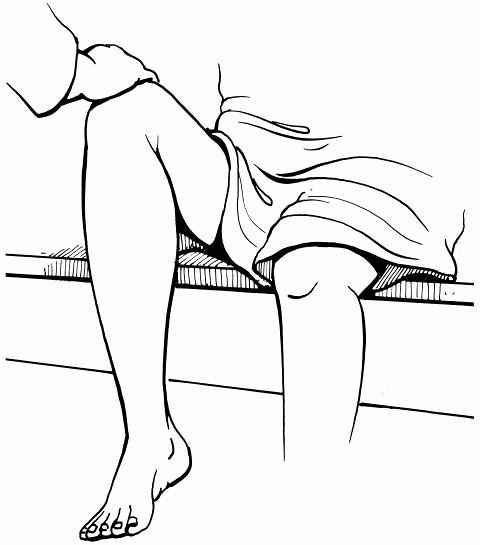 |
|
Figure 26-1
Examination of hip flexor (iliopsoas) strength. Ask the patient to lift his or her thigh off of the bed or examining table, and then ask the patient to resist you as you try to push the thigh down. What you might say as you test the strength: “Don’t let me push your thigh down.” |
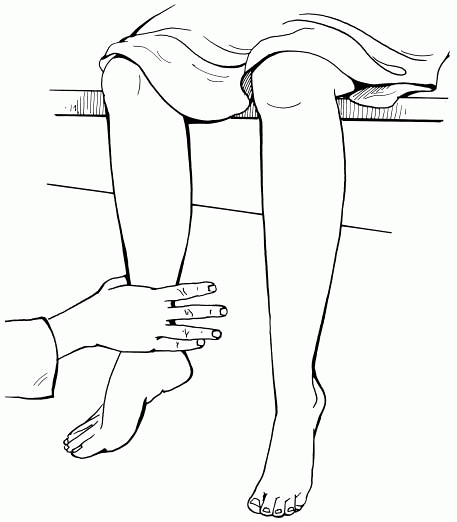 |
|
Figure 26-2
Examination of knee extensor (quadriceps) strength. Starting with the patient’s leg bent (flexed) at the knee, ask him or her to attempt to extend the leg at the knee against your resistance. What you might say as you test the strength: “Push your leg against me.” |
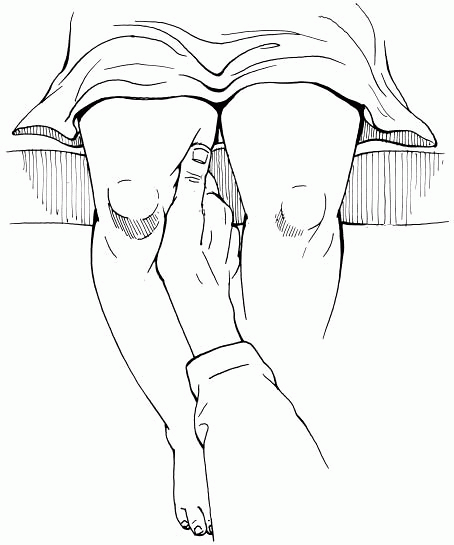 |
|
Figure 26-3
Examination of thigh adduction (adductor) strength. Starting with the patient’s thigh relatively parallel to the trunk, ask the patient to resist you as you attempt to abduct his or her thigh. What you might say as you test the strength: “Keep your thigh in the center, and don’t let me pull it to the side.” |
 |
|
Figure 26-4
Examination of knee flexor (hamstrings) strength. Starting with the patient’s leg bent (flexed) at the knee, ask him or her to resist your attempt to straighten the leg. What you might say as you test the strength: “Don’t let me straighten your leg.” |
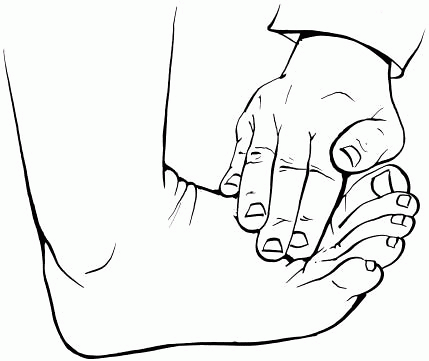 |
|
Figure 26-5
Examination of foot dorsiflexor (tibialis anterior) strength. Ask the patient to lift his or her foot up by bending at the ankle, and then ask him or her to resist you as you attempt to push down on the foot. What you might say as you test the strength: “Don’t let me push your foot down.” |
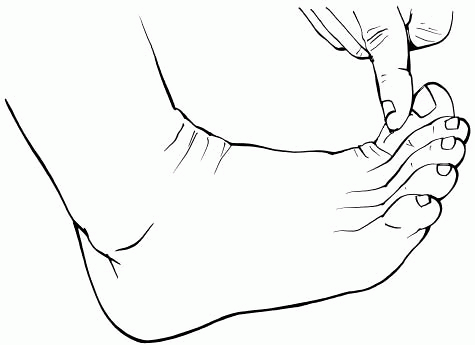 |
|
Figure 26-6
Examination of large toe dorsiflexor (extensor hallucis longus) strength. Ask the patient to lift his or her large toe upward, and then ask him or her to resist you as you attempt to push the toe down. What you might say as you test the strength: “Don’t let me push your toe down.” |
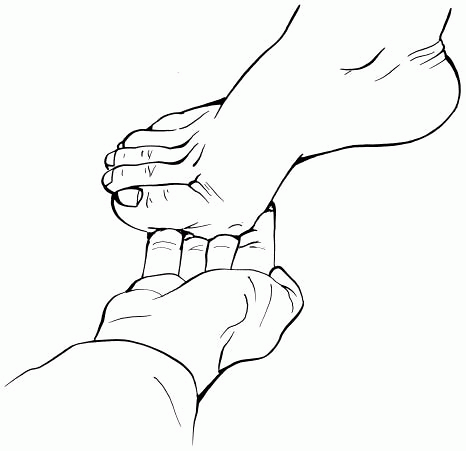 |
|
Figure 26-7
Examination of foot plantar flexion (gastrocnemius) strength. Ask the patient to push his or her foot down, bending at the ankle (“as if you are pushing on a gas pedal”) and then ask the patient to resist you as you push upward on the sole. What you might say as you test the strength: “Don’t let me push your foot up.” |
 |
|
Figure 26-8
Examination of foot eversion (peroneus longus) strength. Ask the patient to turn his or her foot outward and upward at the ankle, lifting the lateral foot upward, and then ask the patient to resist you as you attempt to push downward on the lateral foot. What you might say as you test the strength: “Don’t let me push down on your foot.” |
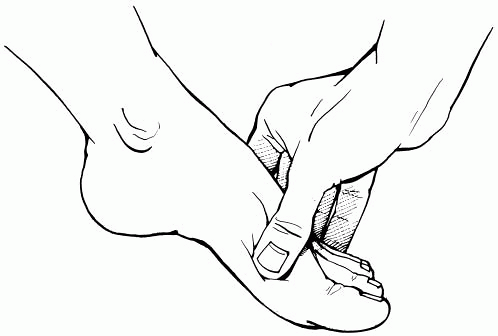 |
|
Figure 26-9
Examination of foot inversion (tibialis posterior) strength. Ask the patient to turn his or her foot inward at the ankle, lifting the medial foot upward, and then ask the patient to resist you as you attempt to push downward on the medial foot. What you might say as you test the strength: “Don’t let me push down on your foot.” |
of all the muscles of the legs that may need to occasionally be tested
to localize a cause of weakness, but they do represent muscles that are
particularly helpful to have a working knowledge of for the majority of
neurologic examinations.
